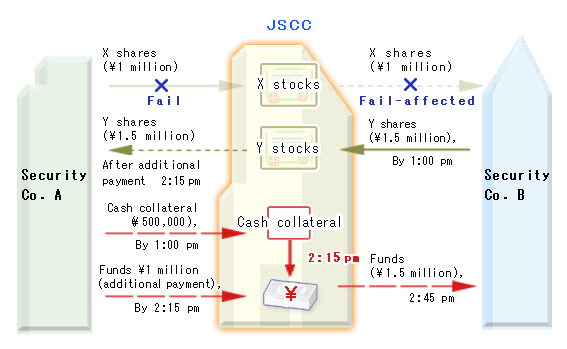Assumption of ObligationFail
Fail
- The case where a delivering participant has failed to deliver securities by the Settlement Cutoff Time for delivery (See Note 1) on the settlement day due to unavoidable circumstances is referred to as “Fail”. (see Figure below) In such a case, JSCC assigns the receiving participants of the failed transaction (= Fail-affected participants) (See Note 2), then carries over the delivery of securities and corresponding payment of funds to the next day. The carried-over position is netted once again with the position which is supposed to be settled on the next day and the net amount is to be settled (JSCC Business Rules, Article 62).
- Provided, however, as a mechanism to ensure the observance of the settlement day and to prevent frequent occurrence of Fails, JSCC imposes penalties (delay compensation, etc.) on participant that causes Fail.
- Meanwhile, Fail can be cleared in any of the three ways as follows.
(1) Delivery of securities on the next day
(2) Re-Netting (See Note 3)
(3) Execution of Buy-In
<Figure> DVP settlement scheme (in the case of Fail occurrence)
- Example) Provisional number of shares and amount of funds for settlement
- Securities Company A:
Securities; Delivers X shares (¥1 million) and receives Y shares (¥1.5 million)
Funds; Pays ¥500,000
Securities Company. B:
Receives X shares (¥1 million), delivers Y shares (¥1.5 million),
Funds; Receives ¥500,000
(Note) Assuming that Securities Companies A and B do not have transactions other than the above.

- The provisional amount of funds settlement (*1) for Securities Company A is paying ¥500,000 (*2), thus Securities Company A is supposed to deliver X shares and pay ¥500,000 as cash collateral to JSCC by 1:00pm. In the case, however, where it fails to deliver X shares due to unavoidable circumstances, it is required to pay ¥1 million, which is the balance due equivalent to X shares, by 2:15 pm (additional payment). Completing this additional payment, Securities Company A is able to receive Y shares at 2:15.
- While Securities Company B was supposed to receive X shares and ¥500,000 by delivering Y shares to JSCC by 1:00 pm, as the result of Securities Company A’s Fail of delivering X shares, B receives ¥1.5 million at 2:45 pm.
- The cash collateral from Securities Company A shall be provided for the funds settlement at 2:15 pm.
- *1:
- The amount of funds settlement is provisional at this point since the payment resulting from Fail is not taken into account.
- *2:
- The amount of ¥500,000 is the difference between the value of Y shares (¥1.5 million) and X shares (¥1 million).
- **Note 1:
- In DVP settlement of the stocks, etc. with which JASDEC deals, the Settlement Cutoff Time for securities, i.e. the deadline for the delivering participant to deliver the securities to JSCC, is 1:00 pm on the settlement day.
- **Note 2:
- Assignment of the receiving participants of the failed transaction (= Fail-affected participants)
JSCC allocates the Fail position according to the respective issue’s priority ranking of receiving participants from the most subordinated group until all the Fail position are allocated. The respective issue’s priority ranking of receiving participants shall be determined as follows.
【The highest priority group】
The long position requested for Buy-In is given the highest priority than the other position.
【Priority group】
Fail-affected participants’ position is given higher priority than other position.
【Subordinated group】
Ranking of participants’ position other than the above, excluding Lowest Priority Group are determined at random.
【Lowest Priority Group】
Participants Submitted Notification for Subordinating Priority in Securities Receipt (See Note 4) shall be set at the lowest priority. However, when multiple Participants submitted the Notification for Subordinating Priority in Securities Receipt for the same issue, the priority among those Participants shall be determined at random.
| Primary priority Basic attributes |
Second priority Buy-In request date |
Third Priority Fail-affected date |
Priority Ranking of receiving participants |
Notes |
|---|---|---|---|---|
| The highest priority group ・Position requested for Buy-In |
Buy-In request day <Earlier group> |
Fail-affected date <Earlier group> |
1st | The rank among the same date shall be determined at random |
| Fail-affected date <Later group> |
2nd | Same as above | ||
| Buy-In request day <Later group> |
Fail-affected date <Earlier group> |
3rd | Same as above | |
| Fail-affected date <Later group> |
4th | Same as above | ||
| Priority group ・Fail-affected participants’ position |
Fail-affected date <Earlier group> |
5th | Same as above | |
| Fail-affected date <Later group> |
6th | Same as above | ||
| Subordinated group(1) ・ETF Special Clearing Participants’ position other than above |
7th | Determined at random | ||
| Subordinated group(2) ・Participants’ position other than above |
8th | Same as above | ||
| Lowest Priority Group ・Participants Submitted Notification for Subordinating Priority in Securities receipt |
9th | The rank among the same date shall be determined at random |
- **Note 3:
- Clearance of Fail by re-netting
The long/short position pertaining to Fail is carried over to the next day and shall be offset against the short/long position which is supposed to be settled on that day. In such a case, Fail position or Fail-affected position can be cleared by re-netting.
- **Note 4:
- As to the issue with respect to which a Participant is to receive securities settlement quantity (excluding the quantity for which buy-in has been requested), the Participant may notify the quantity it may admit subordination of its order in the priority among receiving Participants on the premise that the participant is approved by JSCC to submit Notification for Subordinating Priority in Securities Receipt in advance.
In case Notification for Subordinating Priority in Securities Receipt has been submitted, the priority of receiving participants in respect of the issue and quantity subject to such Notification shall be set at the lowest priority.
JSCC’s approach to reduce Fails
- When a delivering participant fails to deliver securities by the Settlement Cutoff Time in the DVP settlement at JSCC due to unavoidable circumstances, the delivery of securities and corresponding payment of funds are carried over to the next day. (JSCC Business Rules, Article 62.)
However, as the market liquidity is provided based on the presumption that transactions are cleared on the settlement day (T+2), which is scheduled at the time of trade execution, JSCC regards Fail as an exceptional incident and forbids causing Fail without good reason in order to ensure reliable market with high liquidity. (JSCC Business Rules, Item2 of Paragraph 2 of Article 62)Therefore, from the viewpoint of curtailing the overall volume of Fails, in other words, ensuring reliability and stability of settlement and reducing the adverse effect on the Fail-affected counterparty, and in order to foster participants’ thorough understanding of the aim of the system, JSCC routinely monitors Fails with a large volume as well as persistent Fails, and clarifies reasons for these Fails with the person in charge of the delivery and requests to clear the Fails as soon as possible. - In addition, JSCC continually compiles Fail occurrence of each participant, and quarterly requests a participant that has frequently caused Fails to reduce them so as to prompt the participant’s review of its internal management structure, etc. (See Note 5)
- **Note 5:
- The number of participants to whom JSCC made a request to reduce Fails is as follows:
Jan – Dec 2003 18 participants in total
Jan – Dec 2004 30 participants in total
Jan – Dec 2005 18 participants in total
Jan – Dec 2006 16 participants in total
Jan – Dec 2007 12 participants in total
Jan – Dec 2008 12 participants in total
Jan – Dec 2009 2 participants in total
Jan – Dec 2010 1 participant in total
Jan – Dec 2011 3 participants in total
Jan – Dec 2012 2 participants in total
Jan – Dec 2013 2 participants in total
Jan – Dec 2014 4 participants in total
Jan – Dec 2015 2 participants in total
Jan – Dec 2016 0 participant
Jan – Dec 2017 5 participants in total
Jan – Dec 2018 7 participants in total
Jan – Dec 2019 2 participants in total
Jan – Dec 2020 3 participants in total
Jan – Dec 2021 0 participant
Jan – Dec 2022 5 participants in total
Jan – Dec 2023 4 participants in total
Jan – Dec 2024 3 participants in total
- Moreover, against the participants who do not seem to remedy the occurrence of Fail despite JSCC’s request (e.g. possible cases of infringement of the rules that prohibit abuse of Fail), JSCC conducts investigations according to its Business Rules (Article 21). If any problem with the participant’s business execution structure, etc. is identified on that investigation, JSCC makes recommendations for improvement according to the Business Rules (Article 37). In addition, after these investigation and recommendation were made, if further measures were deemed necessary for the participant, JSCC conducts hearing from the participant in advance and gives the instruction to improve its system for business operation, etc. (JSCC Business Rule, Paragraph 1 of Article 29), as well as informs the other participants with the same clearing qualifications thereof (JSCC Business Rules, Paragraph 5 of Article 34).
- As mentioned above, JSCC imposes financial burden on the participants causing Fail as outlined below.
| Type | Rate | Reasons for charges, etc. |
|---|---|---|
| Delay compensation | ¥0.04 per ¥100 of the Fail value per day (See Note 6) | From the day of occurring Fail |
| Delay penalty | ¥0.02 per ¥100 of the Fail value per day | Delay penalty is charged in addition to the delay compensation on Fail persisting 5 days or more after the original settlement day. |
| Special delay penalty for term-end issues, etc. | ¥0.08 per ¥100 of the Fail value per record date | In the case where Fails occur on a record date. |
- **Note 6:
- If such day falls on a day that is immediately preceding a holiday, the amount obtained by multiplying the DVP Clearing Price on the day by the quantity of the securities pertaining to the Delivery Failure, and then multiplying the resultant value by the number of holidays to the next day of the relevant day plus one. (Calendar basis calculation)



